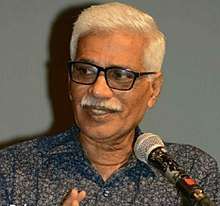Madhav Borkar
Madhav Borkar (also Borcar, in Konkani वेणी माधव बोरकर) is a noted Konkani poet, former station director of All India Radio and Konkani litterateur based in Goa, India.
Madhav Borkar (also Borcar, or Veni Madhav Borkar) | |
|---|---|
 | |
| Born | Madhav Borkar (Borcar) June 4, 1954[1] Goa, Portuguese India |
| Alma mater | People's High School |
| Genre | Poet |
Work, life
Borkar was earlier station director of All India Radio, Panaji (Panjim). As a broadcaster, he has also worked in the government-run radio stations at Mumbai, Mangalore and Kolhapur.
In 2015, Borkar replaced Pundalik Narayan Naik as the president of the Goa Konkani Akademi.[2] In March 2018, he completed 50 years in poetry, and has published eight volumes of verse.[3] He is married to Mankarnika and they have two children, daughter Yogini and son Chinmay.[1]
Literary output
Borkar wrote poetry since 1968. His first collection was published while he was still a schoolboy. At the age of 15, his Chanvar got into print. He has six collections of poems and two translations -- Kabir by Prabhakar Machve and Ekshem Ek Kavita by Rabindranath Tagore.[1]
His poetic works
- Chanvar (The Bloom, 1969)[4]
- Vatacheo Savalleo (The Shadows of Sunlight, 1972),
- Uzvadacho Rookh (The Tree of Light, 1975),[5]
- Parjallachem Daar (The Door to Brightness, 1986)[6]
- Yaman (Yaman, 1999),[7]
- Avyaktaachim Gaannim (Songs of the Unexpressed, 2002),
- and Symphony (Symphony, 2012).[1]
- Molabachem Zonel.
Awards, etc.
Earlier in his writing career, he received the Indian Sahitya Akademi award in 2001 for Yaman, a poetry collection.[8]
Critical response
Nandkumar Kamat describes Borkar as being part of the "second generation" of post-(Indian) Independence Konkani poets along with Nagesh Karmali, Shankar Parulkar, Pundalik Naik, Ramesh Veluskar, C. F. (Chafra) da Costa, Olivinho Gomes, Suresh Borkar, Jesse Fernandes, Prakash Padgaonkar, Kashinath Shamba Lolayenkar and Ramkrishna Zuarkar. In Kamat's listing, he names B.B.Borkar, Manoharrai Sardessai, Abhijit and R.V. Pandit as the post-Independence poets in Konkani who "made major contributions whereas Pandurang Bhangi, Shankar Ramani, Shankar Bhandari [and] Vijaya Sarmalkar began to publish their poems."[9]
Manohararāya Saradesāya (Manoharrai Sardesai) calls his work "terse, abstract yet appealing".[10]
References
- "Meet the Author: Madhav Borcar" (PDF). Sahitya Akademi. Archived (PDF) from the original on 3 July 2018. Retrieved 3 July 2018.
- "Veteran Konkani poet Madhav Borkar took charge of office as the president of Goa Konkani Akademi in Panaji on Monday. - Times of India". The Times of India. Archived from the original on 3 July 2018. Retrieved 21 June 2018.
- "GOA365 VIDEO: Balcao - Madhav Borkar Celebrates 50 Years of his Poetry". Goa365. Archived from the original on 21 June 2018. Retrieved 21 June 2018.
- Borkar, Madhav (1969). Chanvar.
- Borkar, Madhav (1975). Ujvadacho Rukh. Goa: Sobit Sahitya.
- Borkar, Madhav (1986). Parzallache Dar. Mumbai: Parijat Prakashan.
- Borkar, Madhav (1999). Yamen. Goa: Mankarnika Venimadhav Borkar.
- "Madhav Borkar appointed GKA president - Times of India". The Times of India. Archived from the original on 17 July 2018. Retrieved 21 June 2018.
- Kamat, Nandkumar (1 January 2005). "Post Independence Konkani poetry: a mini-review". Golden Jubilee Issue of National Sahitya Akademy. Archived from the original on 21 June 2018. Retrieved 21 June 2018.
- Saradesāya, Manohararāya (2000). A History of Konkani Literature: From 1500 to 1992. Sahitya Akademi. ISBN 9788172016647. Archived from the original on 21 June 2018. Retrieved 21 June 2018.
External links
- Veteran Konkani poet Madhav Borkar took charge of office as the president of Goa Konkani Akademi in Panaji on Monday
- Noted Konkani poet Madhav Borkar, on the work of Manohar Rai Sardessai and the new book (in English)
- Goa Konkani Akademi President Madhav Borkar speaking during a book release (in Konkani)
- One work on Poetry India
- Some Goan Konkani poets
- Balcao - Madhav Borkar Celebrates 50 Years of his Poetry